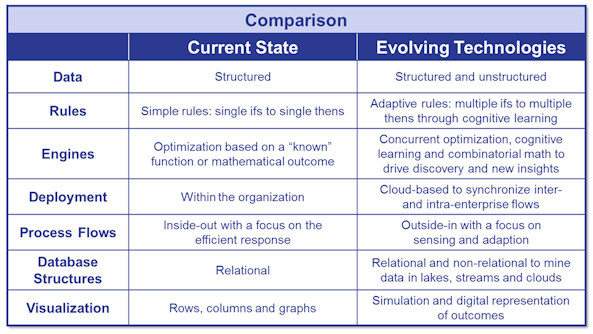Recently, I served as a panelist on a webinar sponsored by Supply Chain Insights. The topic of focus for the webinar was “Big Data and Analytics” and how they relate to the supply chain. The panel was moderated by Supply Chain Insights founder and CEO Lora Cecere (@lcecere). Other panelists included Dave Shuman, Consumer Products & Retail SME at Cloudera; Ester Pescio, CEO of Rulex; and Sean Riley (@1seanriley), Global Manufacturing & Supply Chain Solutions Director at Software AG. Two interesting threads wove their way into most of the webinar’s discussions. The first thread was the unanimous belief of all panelists that the most successful companies in the future are going to be the ones that embrace a culture of experimentation and innovation. The second thread, which also had the consensus of the group, was the belief that to be successful in the future a business must become a digital enterprise. Let me discuss the latter thread first.
The Digital Enterprise
Generally speaking a digital enterprise is an organization that leverages digital technology as a competitive advantage in its internal and external operations. Deloitte puts it this way, “Maintaining a competitive edge means building a Digital Enterprise that’s capable of taking full advantage of social, mobile, web, cloud and analytic technologies. … It requires integration of people, processes, and capabilities to deliver an omni-channel experience.” Chris Perretta, CIO for State Street Bank, told Michael Fitzgerald, “In the old days, like last week, you built systems in functional towers, based on what process you need to automate and what function you need to do for the business.”[1] According to Perretta, that approach simply won’t work in today’s digitized world. According to Perretta, a digital enterprise is “a company whose business rules and policies are completely digital, where people’s jobs are represented in digital fashion and, most importantly, a technology ecosystem that takes the company’s information and makes it both secure and, for those with the right access, easy to find and share.”
Paul Willmott (@WillmottPaul), leader of McKinsey Digital, writes, “It’s safe to assume virtually all companies use digital technology in some form or another. Yet getting beyond obvious and small applications of technology to drive the creation of truly ‘digital enterprises’ is vital — and presents a challenge for executives.”[2] He insists that companies need to do four things if they want “to hit their digital sweet spot.” He explains:
“Firstly, they need to understand, really, where is the value of digital? Is it in marketing? Is it in sales? Is it in automating operations or a combination of all of those? Secondly, they need to prioritize. There are always too many things to do in the digital portfolio, and focusing on the ones that count is important. Thirdly, they need to take an end-to-end view, ensuring that customers receive a joined-up experience from end to end and that all functions are working together. And then, finally, they need to look at their portfolio of businesses and understand what impact digital may have on valuations, and they should focus on what the needed or required capabilities are going forward and perhaps rebalance the portfolio accordingly. Perhaps what is most challenging for organizations is to operate in a joined-up, end-to-end way. Many organizations are siloed around different functions or geographies. But digital customers expect a fully consistent and joined-up experience. And that requires companies to think quite differently about the way they organize, their governance structures, and their standards for data and systems.”
If that sounds challenging then Willmott has done his job. It IS challenging. That’s why the panelists in the webinar stressed the importance of using solutions that take advantage of technologies that automate business processes and learn as they go (i.e., cognitive learning). The use of advanced technology is essential because digitization is changing the business landscape in dramatic and permanent ways. The rise of the Internet of Things (IoT) by itself is going to fundamentally change the way business is conducted as well as dramatically increase the amount of data that is going to be created and will need to be analyzed. Lora displayed a chart that compared the current state of technology with evolving technologies that are going to permit companies to become digital enterprises. The chart is shown below.

Sean told webinar participants that new technologies are going to permit users to make better and more informed decisions and that, as a result, management by exception is going to play a larger role in the business world (especially in areas like asset tracking). I noted that the ability to automate rules using various computational engines is going to help supply chain (and other business) professionals deal with increasing levels of complexity. Cognitive computing is going to allow decision makers to consider many more variables in their models than they have been able to deal with in the past. Ester agreed that the ability to automate rules is one of the most exciting things currently taking place in the business world. Dave added that the ability to “mash up data sources” is one of things making advanced analytics so beneficial. He called it, “The power of ‘and‘.”
Experimentation and Innovation
During the webinar, Lora asserted, “We have not built organizations for discovery.” She went on to note that it is difficult for many progressive leaders to find ways to fund new initiatives in this era of belt tightening. The logical place to start with new initiatives, Lora asserts, is in Supply Chain Centers of Excellence. Panelists agreed that companies are going to have to create a new culture in which employees are trained to use technologies to help them do their jobs better. I pointed out, for example, that technologies with embedded analytics can free employees from having to worry about how to do the analytics so they can focus on what the insights produced by the analytics mean for advancing business goals. They are also going to have to be more interdisciplinary in their thinking. Lora noted that companies led by “naturally curious leaders” are better positioned to foster the kind of corporate culture needed by digital enterprises. I agreed with Lora and indicated that in my experience the companies most willing to consider cognitive learning solutions are already the leaders in their categories. Enlightened executives are one reason those companies became category leaders. As an example, I noted that the CEO of Hershey’s sees his company as an analytics and insights firm that happens to sell confectionary products.
Lora indicated that in her experience the best companies are those that have a mindset that encourages testing and learning. Sean indicated that the best way to approach experimentation and innovation is to “start small and think big.” I agreed with Sean that rapid prototyping is essential to convince companies that projects are worth scaling. I call this a “crawl, walk, run” approach. Ester reminded the webinar audience of what Albert Einstein once remarked, “We cannot solve our problems with the same thinking we used when we created them.” One way of ensuring that you use new thinking is to address problems using machine thinking (i.e., artificial intelligence and cognitive learning). She added, “The best way to learn is by doing.” Dave said, “I see your Einstein and raise you one Newton. Remember Newton’s first law: ‘An object that is at rest will tend to stay at rest unless an external force acts upon it.’ So find an interesting problem, pose a hypothesis that can be proved or disproved through data, and, to quote Ester, just do it.”
George Westerman (@gwesterman), a research scientist at MIT’s Initiative on the Digital Economy, told Fitzgerald, “What’s new about the digital enterprise is the emergence of all these new technologies coming together at the same time.” He added, “What we find with digital transformation work is that it’s not really a technology problem, it’s a leadership problem.” If you are not transforming your company into a digital enterprise and if you’re not open to innovation, you’re going to find yourself trying to compete in a world where everyone else is playing by different rules and those rules will probably be automated.
Footnotes
[1] Michael Fitzgerald, “Top CIOs Start the Journey to the ‘Digital Enterprise’,” CIO, 28 October 2014.
[2] Paul Willmott, “The Digital Enterprise,” Insights & Publications, November 2013.





